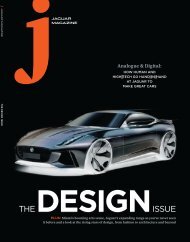JM_0216_UK
You also want an ePaper? Increase the reach of your titles
YUMPU automatically turns print PDFs into web optimized ePapers that Google loves.
F-TYPE<br />
For as long as Texas has been part of the United<br />
States, the unfamilar have endeavoured to cross it<br />
quickly. 660 miles wide from east to west, a<br />
landmass roughly the same size as France, and a<br />
population that has endured annexation, secession,<br />
rejection and caricaturisation the state has an unofficial<br />
motto: ‘Don’t mess with Texas.’ Then again many<br />
Americans would choose to cross almost all of the ‘flyover<br />
country’ between New York City and Los Angeles as<br />
quickly as possible. Or indeed fly over it. Meanderings is<br />
not encouraged.<br />
In the 1970s, it became<br />
competitive to the point of<br />
brinksmanship to crisscross the<br />
U.S. as fast as possible, in<br />
protest of a national speed<br />
limit set at 55mph. The<br />
Cannonball Baker Sea-To-<br />
Shining Sea Memorial Trophy<br />
Dash, led by the late Brock<br />
Yates and Car and Driver<br />
magazine, encouraged a<br />
whatever-it-takes mentality to<br />
cross the country as quickly as<br />
possible on four wheels.<br />
Today, the Cannonball Run<br />
has earned its place as the record to beat. Early attempts<br />
to cross 2800-odd miles of American tarmac touched the<br />
40-hour threshold, in a panel van, no less. Scant time was<br />
spared for bathroom breaks or feeding and much less so<br />
for getting a sense of what makes America so beautiful.<br />
The overall, virtually unbroken record belongs to two<br />
blokes who made the journey in 32 hours and 51 minutes in<br />
a Jaguar XJS in 1979. That was the last year of the<br />
Cannonball, and the record stands.<br />
Food for thought, that was. Instead of pursuing a mad,<br />
transcontinental dash, what would happen if you slowed<br />
down to explore what’s sandwiched in between the allimportant<br />
coasts? Once you begin to take it easy, would<br />
the real culture and colour of Texas, without which the two<br />
coasts would be at a deficit, come in to focus? And time to<br />
explore the cities; is Austin really as cosmopolitan as Los<br />
Angeles and San Antonio still urban to a ranch hand? I’ve<br />
also heard it said the rocky countryside and vast swaths of<br />
basically unoccupied towns between the state’s four great<br />
cities make you wonder if you’re still on the same continent,<br />
let alone the same state.<br />
Instead of a mad,<br />
transcontinental<br />
dash what would<br />
happen if you<br />
slowed down?<br />
The proposition was to connect four of Texas’ largest<br />
cities, beginning in Dallas, where an F-TYPE SVR was<br />
waiting (we needed a Jaguar to honour that record<br />
properly; a 575bhp F-TYPE SVR, seemed an appropriate<br />
heir to the expeditious, time-setting Jag).<br />
It’s no joke about everything being bigger in Texas: the<br />
parking lot just outside Dallas-Fort Worth airport<br />
comprised acres of asphalt, protective canopies (from<br />
errant hailstorms) and showrooms’<br />
worth of pickup trucks. You could<br />
get lost here. The shuttle driver<br />
hardly believed me when I said I<br />
was there to collect a Jaguar, let<br />
alone the quickest model the<br />
company has ever produced. He<br />
laughed a little when he saw the<br />
silver coupé among all of the halftons<br />
and SUVs.<br />
You quickly get a sense that<br />
Texas likes to cling to its history,<br />
but you wouldn’t learn that from<br />
spending time in Dallas, a city in<br />
constant regeneration. In its<br />
suburbs, Fortune 500 companies<br />
are laying claim to campuses and pushing the city’s limits, à<br />
la Los Angeles. Downtown is a collection of high-rises and<br />
few residents. It’s a backdrop for AnyTown, USA. The roads<br />
are flat and straight, and don’t really lead anywhere. Sure,<br />
there are luxurious department stores and plenty of venues<br />
to find Tex-Mex food and Country and Western music, but a<br />
better way to get a sense of Texas is to get out of Dallas.<br />
Luckily, all it takes is a quick trip down one of the state’s<br />
unique ‘farm-to-market’ (FM) roads and a wide-open map.<br />
The FM roads are a living reminder of Texas’ economic<br />
history of moving products from the farm or ranch to a<br />
market. They’re usually the ones worth driving.<br />
An hour outside Dallas, en route to Austin, is the town of<br />
Clifton. It is the opposite of Dallas. You’d never know it even<br />
existed without a map. A main street runs through the city;<br />
it’s a quaint collection of storefronts and a living portrait of<br />
postcard Americana. The high point is a coffee shop that<br />
was formerly a drugstore, replete with a counter and syrups<br />
station. Leaving Clifton en route to Austin, a series of<br />
70 THE JAGUAR




